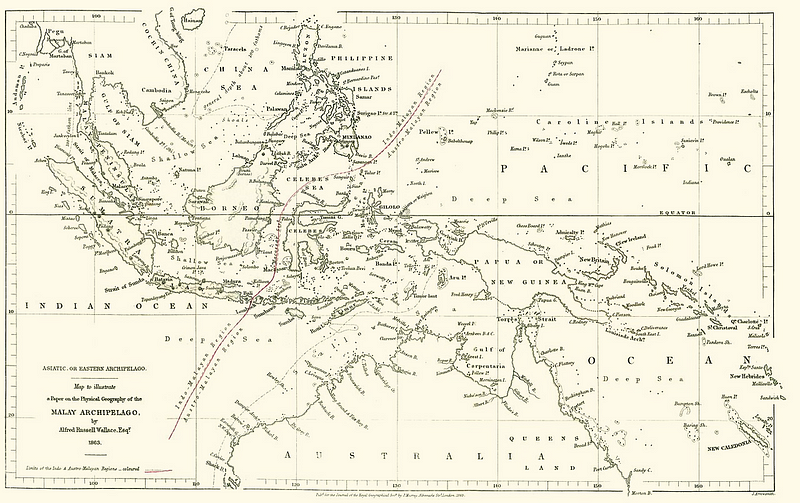The Wallace Line: Unveiling Nature's Invisible Barrier
Written on
Chapter 1: Understanding the Wallace Line
A historical map of the Malay Archipelago created by Alfred Russel Wallace in 1863 illustrates the initial concept of the Wallace Line.

The Wallace Line, identified by British naturalist Alfred Russel Wallace in 1859, serves as a crucial biogeographical boundary in Southeast Asia. This imaginary demarcation distinguishes the animal life of the Asian and Australian regions, specifically lying between the Indonesian islands of Bali and Lombok. It extends further through the Makassar Strait, separating Borneo (Kalimantan) from Sulawesi, and continues northward between the Philippines and the Celebes Sea islands.
During his explorations, Wallace noticed a stark difference in animal species on either side of this line. The western islands, including Bali and Borneo, shared their fauna with mainland Southeast Asia, hosting species such as tigers, rhinoceroses, and monkeys. In contrast, the eastern islands, like Lombok and Sulawesi, revealed a closer resemblance to Australian wildlife, featuring marsupials and other distinctive Australian animals.
Renowned for his contributions to natural selection theory alongside Charles Darwin, Wallace's mapping of this biogeographical barrier in 1863 highlights its significance. The Wallace Line is more than a mere divider; it signifies a transitional area between two diverse biogeographic realms, fundamentally influencing the evolution and distribution of species through a phenomenon known as vicariance.
Vicariance describes the process where a single population becomes fragmented into isolated groups due to the emergence of physical barriers such as seas or mountains. During the Pleistocene epoch, which lasted from approximately 2.6 million to 11,700 years ago, lower sea levels allowed land bridges to form between certain islands. This facilitated the migration of some species while leading others to become isolated.
Section 1.1: The Impact of Climate on Species Distribution
The Wallace Line has long puzzled ecologists due to the uneven distribution of species across it. The intriguing question focused on how Asian species could migrate one way while Australian species remained confined in the opposite direction, with no clear explanation for this pattern.
Recently, a new theory has come to light regarding the unusual distribution of species across the Wallace Line. Researchers suggest that significant climate changes resulting from tectonic activity around 35 million years ago may have played a pivotal role. During this time, Australia broke away from Antarctica and collided with Asia, giving rise to the Malay Archipelago.
The video "The Wallace Line: Ring of Fire - Tectonic journeys in E Asia" delves into the tectonic movements that influenced the distribution of life in Southeast Asia.
Subsection 1.1.1: A New Perspective on Species Adaptability
In a groundbreaking study, scientists employed a computer model to analyze how climatic shifts caused by continental drift affected various animal species. The model factored in aspects like dispersal capabilities, ecological preferences, and evolutionary relationships of over 20,000 species on both sides of the Wallace Line.
Findings indicated that Asian species were notably more adaptable to the conditions prevalent in the Malay Archipelago during that period. The research revealed that the climate changes had varying impacts on different species. While Southeast Asia and the newly formed Malay Archipelago experienced warmer and wetter conditions, Australia faced colder and drier climates.
As a result, Asian species thrived in the Malay islands, using them as pathways to migrate towards Australia. Unfortunately, Australian species did not have the same advantages. Researchers are optimistic that insights from their model could help predict how current climate change may affect living species today.
The video "The Invisible Line in the Indian Ocean" explores geological mysteries beneath the Indian Ocean that contribute to our understanding of species distribution.
Chapter 2: Conclusion
The Wallace Line remains a vital concept in understanding biogeographical patterns and evolutionary processes. As climate continues to change, the insights gained from studying this boundary could provide valuable knowledge for predicting how species may adapt in the future.